Hello,
Several FFFs ago we have shown you what a Space platform can look like (FFF-373), today we would like to explain how they work in a bit more detail.
What are Space platforms?
Space platforms are little (or not) flying factories that act as the means of transportation between planets, both for items and players.
Birth of a platform
You start by launching an item called "Space platform starter pack" into space. The item is inserted into the rocket silo in a similar way to the satellite.
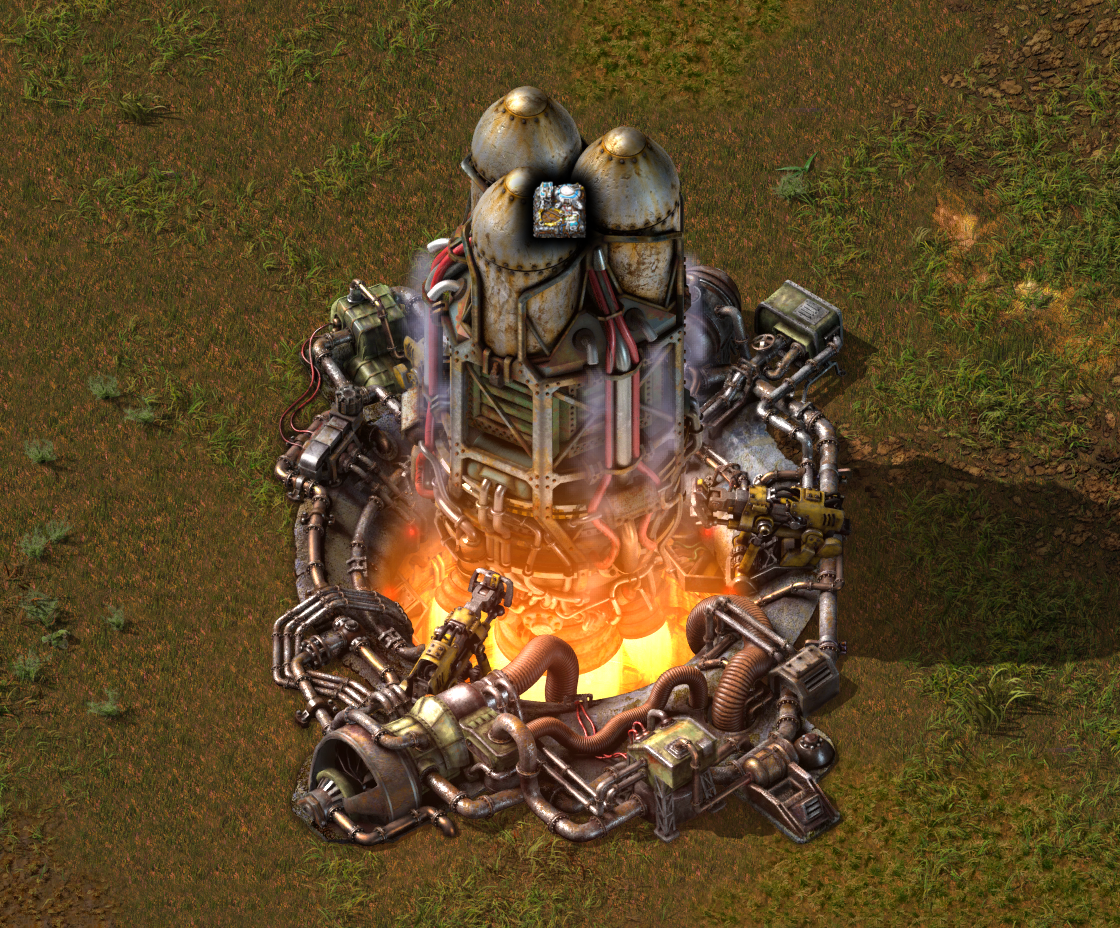
This rocket is carrying a space platform starter pack, as you can tell from looking at the alt-mode overlay.
Space platform hub
The initial platform has only one structure - the space platform hub. The hub is a 1-per-platform central entity which stores items for both construction and logistics, has logistic requests, and a train-like schedule where planets act as stops.
If the hub is destroyed, the entire platform is lost.
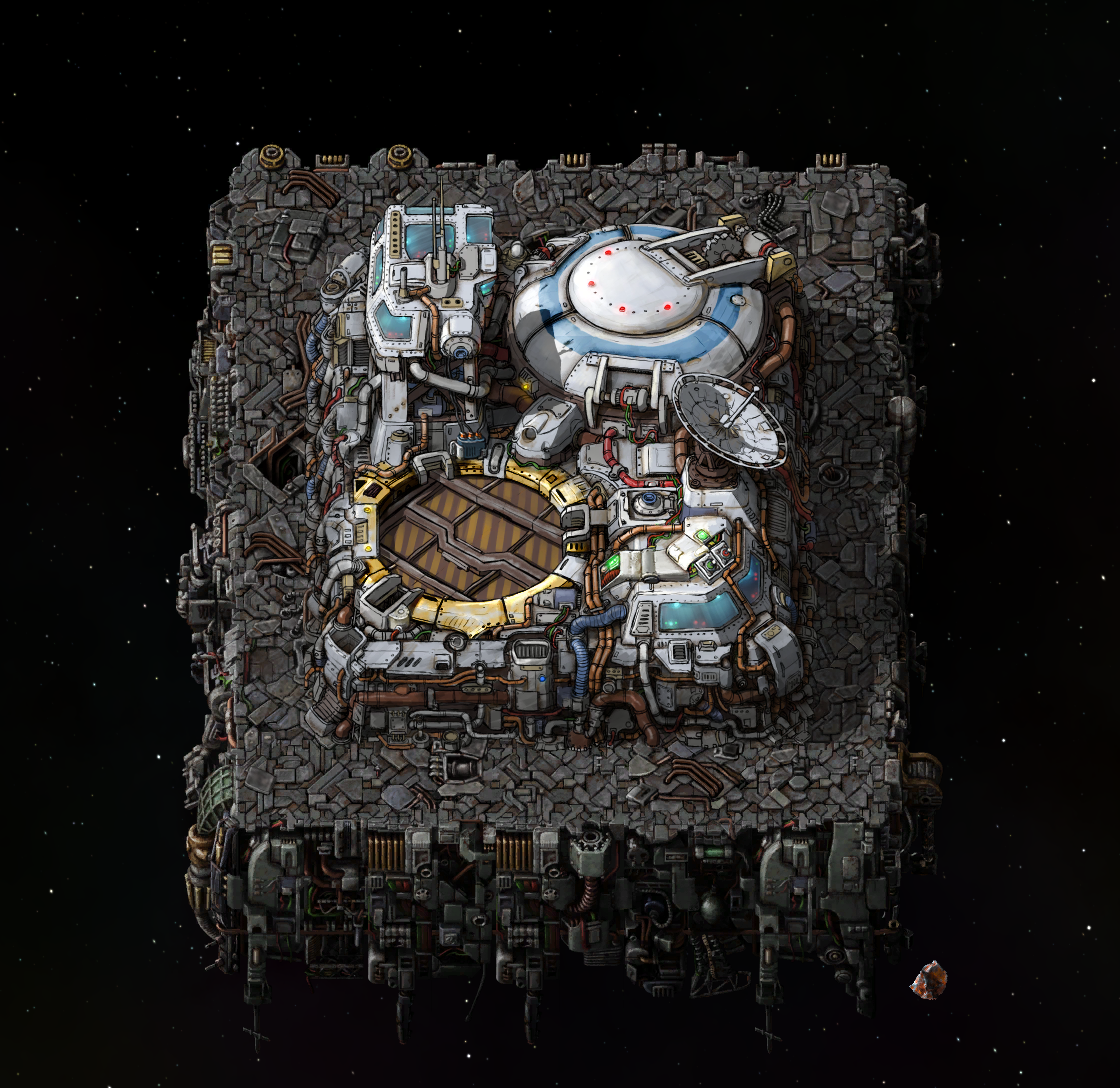
Space platform hub, the centerpiece of every space platform.
Many of you could tell earlier that the graphics of the space platform hub are a concept art placeholder, while the real version is being worked on.
The inventory of the space platform hub is limited, but so called cargo bays can be constructed next to the hub to increase the capacity.
Mp4 playback not supported on your device.
The graphics aren't yet finished, but you can already see how the hub and cargo bays will visually attach.
Jaroslaw's sanity is now somewhere deep in these pixels, if you find it please send it back.
Initially, we were trying a different system, where the cargo bays would be separated entities, and you would have to shuffle things around, but it was just a non-fun bookkeeping activity, so we just went with one big central inventory.
How do things get to Space platforms?
The next part was clear and unchanged form the beginning: Rockets are used to bring items to platforms, and this part is the main price of delivering items into space or other planets.
But the rest went through an evolution.
The original plan was, that it would be part of the logistic challenge to transport and insert all the required items directly into the rocket silo. Everything in the silo would be available to the "orbital logistic system", which pulls required items from available rocket silos.
The problem was, that the actual gameplay produced by this system proved to be incredibly annoying very quickly. The reason is, that you need many different items in small quantities to build all the platform mini-factory and the only reasonable solution to do that was weird.
You had to filter the inventory slots in the silo, so each of the items would have a dedicated space, and then to bring every individual item to the silo.
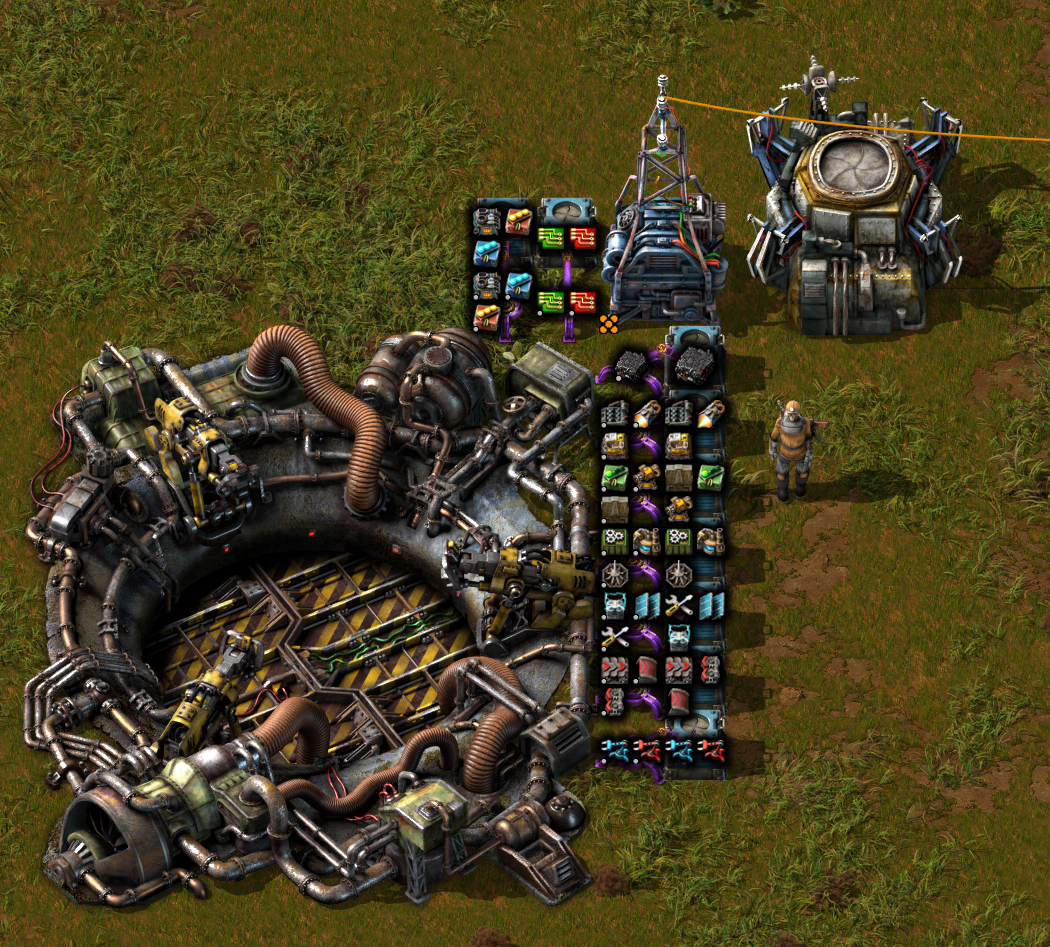
Configuring this wasn't fun. On top of that, all the items had to be backed-up in the silo AND the chests.
We needed a way out, so we added 3 semi-separated features to fix this pain:
- The rocket silo is directly connected to the logistic network and works as a requester chest.
- The rocket silo can be configured (a checkbox), to automatically request things needed by the platform above from the local logistic network. Note that this is only activated when the items are already present in the network in the needed quantities.
- When you are placing ghosts on the space platform, the space platform can be set to automatically request these items from the surface of the local planet
With these 3 things combined, you can just build ghosts on the platform, and everything is done automatically, assuming you have the items already available in your logistic network.
The important part is that you can still ignore the logistic network, and stockpile the silos manually, which can be very practical in special situations, or basically required in some of the yet-undisclosed Space Age content, but it is an exception.
Asteroids as a resource
In space you encounter asteroids which are both a resource and a hazard.
They come in various sizes, asteroid chunks are the tiniest and don't do any damage to the platform when they hit it. Chunks can also be caught by the mechanical tentacles of asteroid collectors to be processed into items.
Mp4 playback not supported on your device.
There are three general asteroid types:
- Metallic asteroids for iron ore used to produce gun turret ammunition and thruster oxidiser.
- Carbonic asteroids for carbon which is a new resource used on the platform to produce thruster fuel.
- Oxide asteroids for ice which is melted into water, then used to produce thruster fuel and oxidiser.
A new machine called a crusher is used to process the asteroids. Later on, more resource types can be obtained from asteroids using advanced crushing recipes.
Mp4 playback not supported on your device.
It can happen that the platform collects too many asteroids or some recipe byproducts just accumulate too much. Here's one simple feature that we love: You can dump items overboard with inserters.
Mp4 playback not supported on your device.
In the past we've had multiple versions of ways how to trash items from platforms, including having a special storage entity which was able to do that. It all got so complicated that in the end we just went with this super simple solution.
Space science - in space
What if we produced space science packs on the space platform instead of by just sending satellites into space? Sounds cool on first sight because it fleshes out the space science pack into something more than just the imaginary "satellites sent us research data from space", but there are even better reasons for it.
In our initial version of space platforms, you would unlock all of their components immediately after the rocket silo.
With that you could go explore planets. This sounds great until you realize that the player isn't quite getting anything useful out of any of this until they have successfully brought science packs back from another planet.
This means, that you had to:
- Make the rocket silo and many rockets.
- Build the space platform.
- Travel to the other planet.
- Solve the challenges of the planet and automate science pack and rocket production there.
That is quite a lot of a big steps to do and it reminds us a similar pacing problem we already had in the past with the oil processing changes covered in the FFF-304 and FFF-305.
So we tried to break this into smaller manageable sub-parts which yield some usefulness/reward on their own. This is helped by effectively having two tiers of space science packs.
Satellites launched into space are still used to obtain the first space science packs, but you only get 10 space science packs for a satellite. You can spend these on a few technologies which cost in the range of 10-30 space science packs each.
Namely, this is where you can unlock tier 2 modules, kovarex enrichment process, space platforms, asteroid collectors, and a new space science pack recipe.
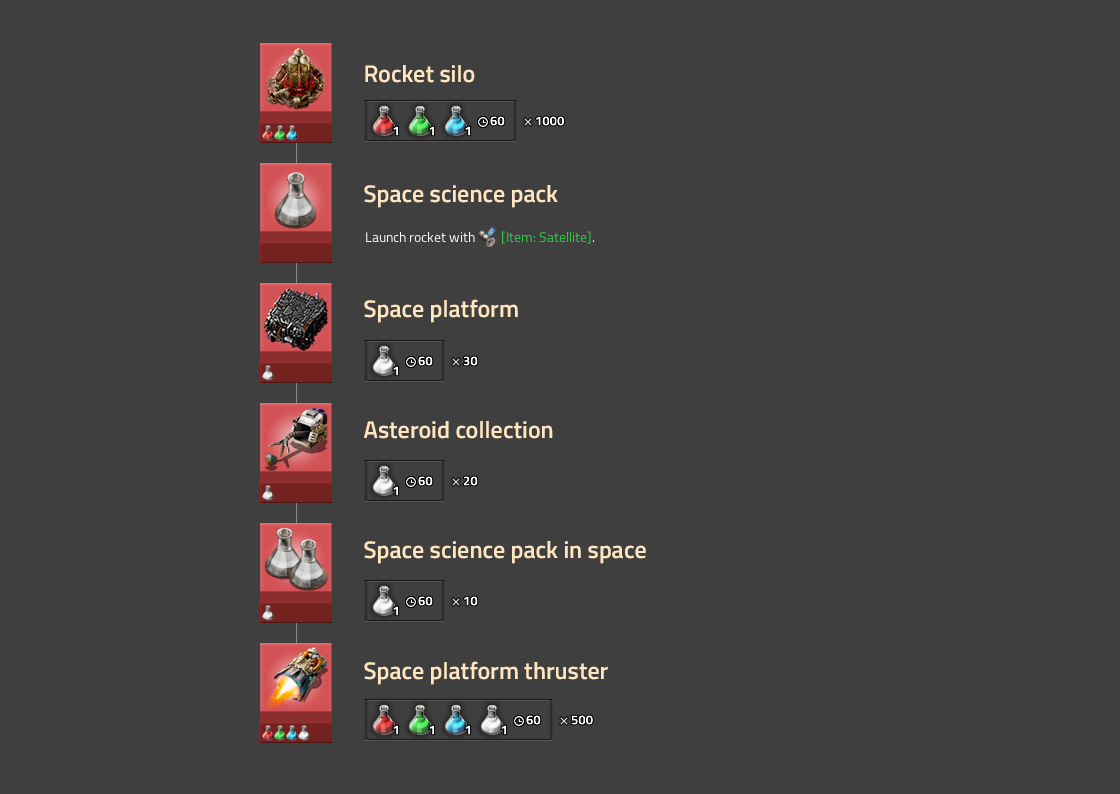
The next step is to construct a basic platform capable of collecting and crushing asteroids.
This platform can combine crushed asteroids with imported uranium from Nauvis to produce science packs in much higher quantities.
With 1 rocket load of enriched uranium you can produce 1000 space science packs in space which makes it 100+ times more efficient than sending satellites into space.
This is effectively splitting the space science technologies in two distinct tiers.
Mp4 playback not supported on your device.
Platform producing space science and putting it into the platform hub from where it will be sent to the surface.
Past this point, technologies return back to costing hundreds/thousands of research points each, normal infinite technologies become affordable so you can finally get more robot speed upgrades, weapon damage upgrades, or unlock the atomic bomb.
This progression is also very useful so the player first gets to grasp the basics of asteroid processing in a safe environment before they need to build a platform which dares to travel away from Nauvis.
Moving space platforms
Space platforms can either be stopped in orbit, or moving between two orbits.
For movement, the platform has some weight based on its size (number of tiles), which is attempted to be moved by the force of the thrusters. This means the bigger the platform, the more thrusters it needs to move fast.
In order to move, the thruster needs to be supplied with fuel and oxidiser, which can be obtained from asteroid resources.
Mp4 playback not supported on your device.
Our platform can now fly, but that isn't without risk...
Asteroids as a threat
The platform must be equipped with defensive turrets because after departing from Nauvis orbit larger asteroids appear. If unchecked, these can heavily damage and eventually completely destroy the platform. On destruction, the bigger asteroids split into multiple smaller ones, eventually turning into the harmless chunks.
Mp4 playback not supported on your device.
Building rules
Everything on Space platforms is done via the remote view (no coincidence it was the topic of the last FFF).
Some entities can't be constructed on platforms at all. For example:
- Robots so the platform remains a belt logistic puzzle.
- Chests to prevent excessive buffering.
- Vehicles including trains and spidertrons for various reasons.
- Burner entities for a bit of realism as there's no atmosphere in space.
Space platforms cannot have holes in tiles, and their surface must be contiguous. If a tile that bridges two sections is destroyed, the section without connection to the hub is destroyed as well.
Mp4 playback not supported on your device.
Power on space platforms
Power is automatically distributed by space platform tiles so you don't need to build electric poles or substations on the platform, allowing for some even denser belt designs.
The platform gets power primarily from solar panels, but power is still rather limited on the platform, as every solar panels adds to the size of the platform which increases its weight, slows it down.
This means efficiency modules are now much more useful than before.
Solar panel output is generally greater in space than on planets, but most planets are further away from the star than Nauvis, and eventually we get to travel to really distant places where solar panels are almost useless. This leaves room for nuclear power being completely viable to be used on space platforms, though it requires a significant amount of water/ice to be gathered from asteroids.
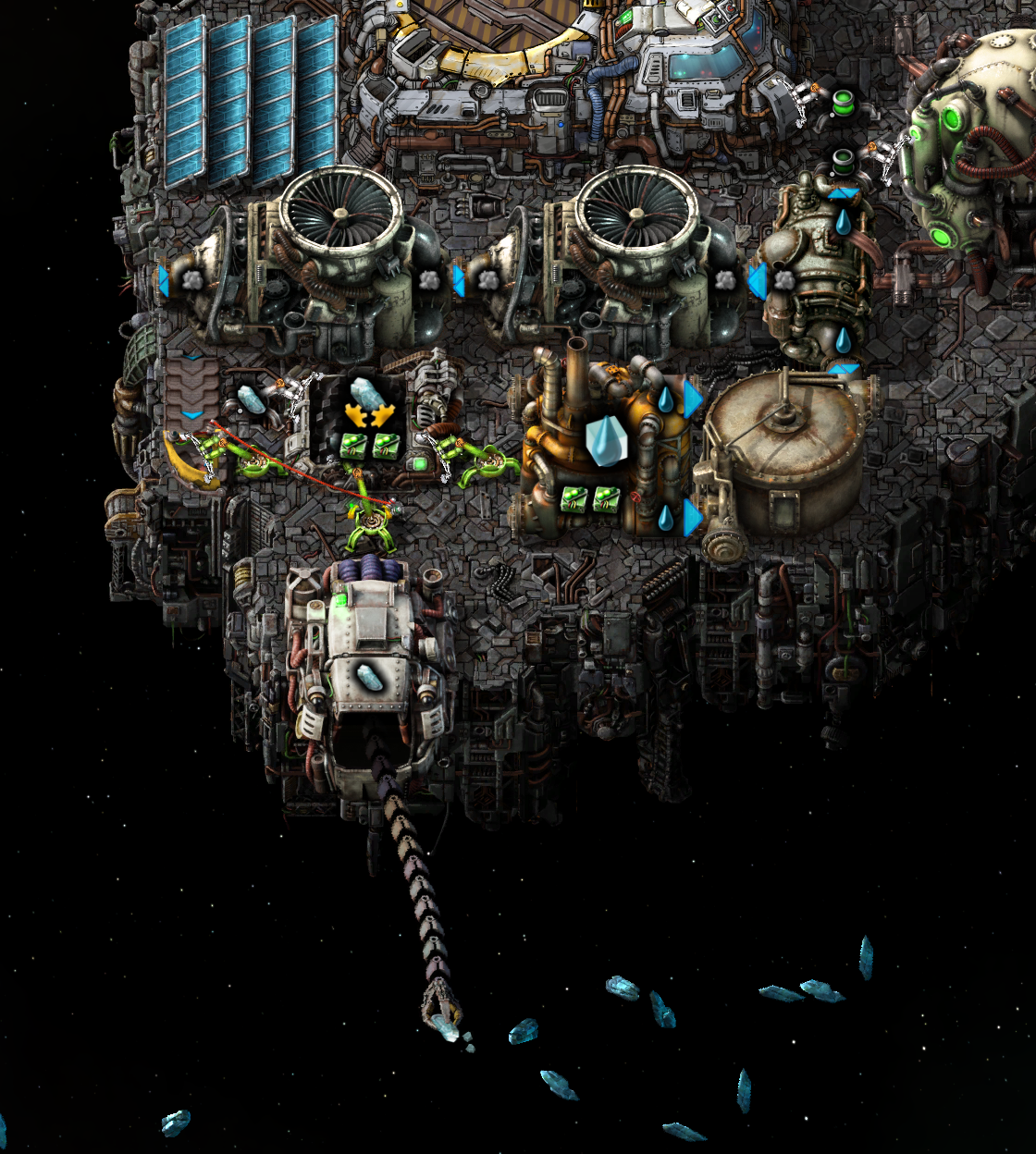
Quality implications
Quality of entities is extremely influential on the platform since its effects basically multiply against each other.
- Higher quality chemical plants produce fuel faster while consuming the same amount of power.
- Higher quality solar panels means you need to use less space so the thrusters have an easier time moving the platform.
- Higher quality asteroid collectors have more arms for catching asteroid chunks.
- Higher quality furnaces and assembling machines can craft ammo faster.
- Higher quality gun turrets have increased range, so they get more time to shoot the asteroids before they would hit the platform.
- In general, higher quality entities have more health, so the platform can tank more hits if an asteroid slips through.
Long story short, if you have a few higher quality items, it might make a lot of sense to use them on the platform.
Mp4 playback not supported on your device.
This is what a platform with legendary components could look like.
The process
The platforms you can see here today achieve quite accurately what kovarex's initial idea was, however we have spent a lot of time finding the right path to get there. The rocket logistics and space platform mechanics were changed very significantly many times. We weren't afraid to rework systems related to the platform in order to make the experience of building them as good as we can imagine.
Apart from the technical mechanics, we've created interesting recipes which don't get too complicated. At the start we had a rough idea of what we want to achieve (somehow craft ammo and something for thrusters), and Earendel has laid out a creative set of recipes. Since then I (V453000) have done a lot of balancing passes and tweaks and we've got something quite solid now.
As you're probably already used to by now, the graphics you can see in this post have taken a lot of effort to make. Though this time it exceeded the trend by quite a bit, and the space platform has been a real team effort more than anything before it.
From the surface of the space platform tiles and decoratives done by Lucas; Space platform transitions, thrusters, crushers and the hub/cargo bays done by Jaroslaw; Asteroid collectors and starfield shader done by Jerzy; to the asteroids done by Fearghall; with all the concept art from Earendel; and oversight from Albert with V453000; we can safely say close to everybody from the GFX department has been involved, and pretty much every one of these tasks has tested our sanity.
Conclusion
It is an undeniable fact that the factory must grow, always. But sometimes it just transcends to the point where it seems like nothing matters anymore and all of the challenges have been trivialized. Survival, space constraints, items feeling like they have any value, and so on.
With the rules of how space platforms are built, we can enjoy these feelings of puzzles to be solved for quite a bit further. While building a platform can be easy by sending more platform tiles to space and giving yourself more room to build, it is always motivating to try to keep the platform compact so it can fly as fast as possible.
Space platforms can specialize in different tasks, so it can be motivating to optimize them for different design goals. You can aim to make a huge platform that can load thousands of items, or a small platform with capacity sacrificed for speed. Would you like a minimal platform so you could get to that first planet as soon as possible, or do you perhaps fancy a gigantic platform that can craft its own components mid-flight? There are quite a few more things to try, but more about that some other day...
It's obvious to compare Space Age's space platforms to Space Exploration's spaceships. While they're both chunks of metal traversing space, their gameplay is very different. Thanks to the asteroid processing, space platforms can operate completely independently without the need to refuel, and it also automatically means they are little (or gigantic) space factories, where space really matters. Due to modding API limitations, SE's spaceships get rather complicated to automate with combinators and so on, in contrast space platforms automatic scheduling is literally as simple as automating trains.
All in all, creating your first automated space platform should be quite easy, but there is a lot of room for making something really big and complex too.
As always, thank you for reading and let us know what you think on the usual platforms.